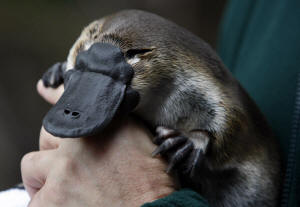Drying habitat makes Australia's platypus vulnerable, scientists say
 Send a link to a friend
Send a link to a friend
 [November 25, 2020]
SYDNEY (Reuters) - Australian
scientists pushed on Monday to list the platypus as a vulnerable species
after a report showed the habitat of the semi-aquatic native mammal had
shrunk more than a fifth in the last 30 years. [November 25, 2020]
SYDNEY (Reuters) - Australian
scientists pushed on Monday to list the platypus as a vulnerable species
after a report showed the habitat of the semi-aquatic native mammal had
shrunk more than a fifth in the last 30 years.
Severe drought brought by climate change, land clearing for farming and
dam-building are to blame, said researchers at the University of New
South Wales (UNSW) who made recommendations to government scientific
panels.
"There is a real concern that platypus populations will disappear from
some of our rivers without returning, if rivers keep degrading with
droughts and dams," said Richard Kingsford, director of the university's
Centre for Ecosystem Science.
The animals, unique to Australia, cannot live outside water, and as the
continent dries further and people draw more water from rivers, some
permanent pools could get even smaller, he added.

The duck-billed animals with webbed feet lay eggs and live mostly across
Australia's eastern seaboard, from the far north of Queensland state to
the island state of Tasmania, close to rivers and streams whose beds and
banks they forage for food.
Platypus numbers may have more than halved over several decades,
research models show, but figures are hard to pinpoint as they are
secretive, nocturnal animals. Conservation body IUCN estimates between
30,000 and 300,000 lived in Australia in 2016.
[to top of second column]
|

An adult male platypus named Millsom is carried by his keeper at an
animal sanctuary in Melbourne May 8, 2008. Australia's unique
duck-billed platypus,an egg-laying, furry animal with web feet that
spends most of its time underwater, is in fact part bird, part
reptile and part mammal according to its gene map. A team of
international scientists released the playtpus genome on Thursday,
saying its complex gene sequence will aid the study of human
evolution, particularly the development of the immune, nervous and
reproductive systems. REUTERS/Mick Tsikas (AUSTRALIA)

Animals are classed as vulnerable when they face a high risk of
extinction in the wild in the medium term, but are not considered
critically endangered. More resources can be deployed to protect
their habitats once they are on the threatened list.
(Reporting by Renju Jose and Stefica Nicol Bikes; Editing by
Clarence Fernandez)
[© 2020 Thomson Reuters. All rights
reserved.] Copyright 2020 Reuters. All rights reserved. This material may not be published,
broadcast, rewritten or redistributed.
Thompson Reuters is solely responsible for this content.
 |